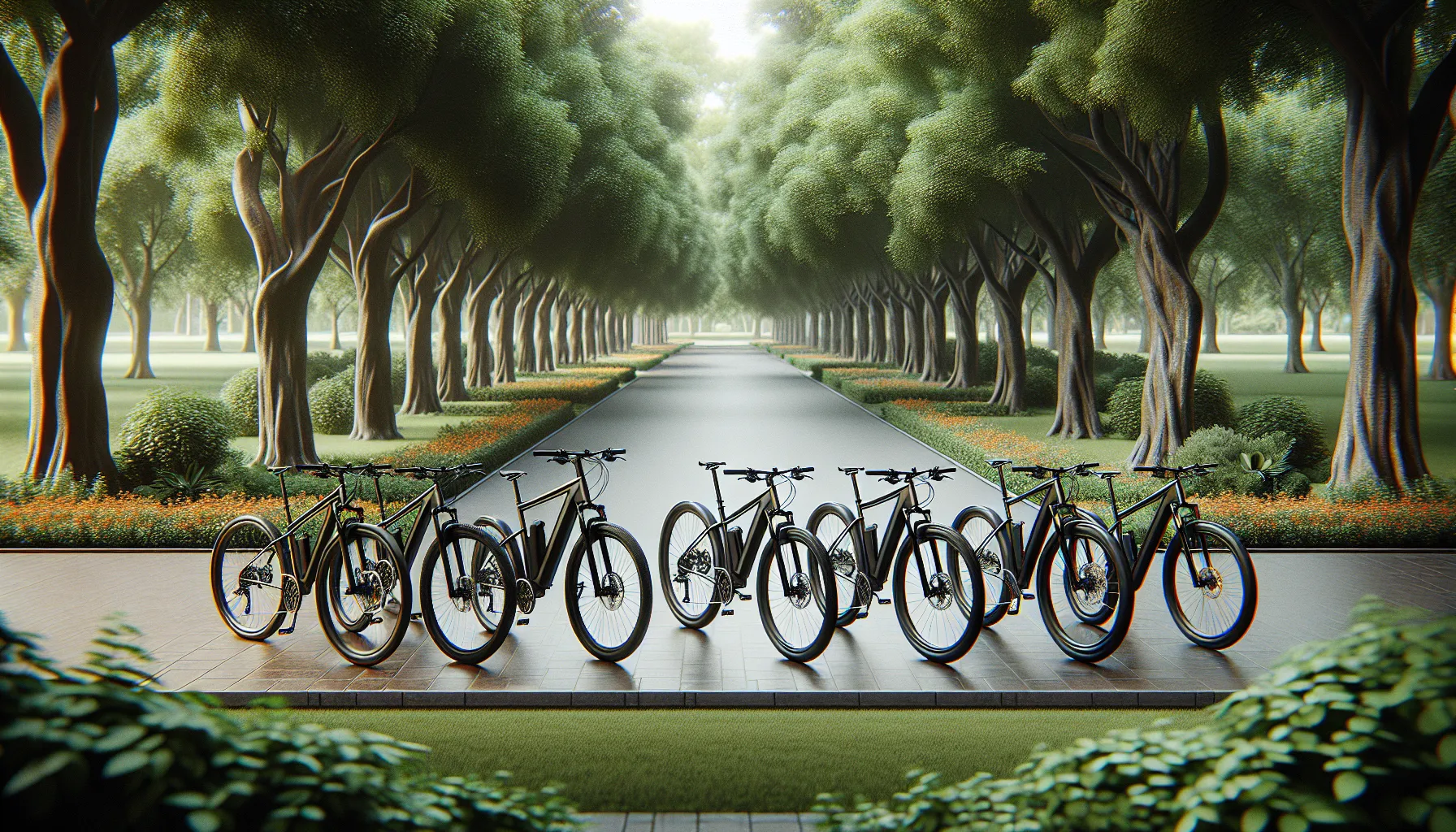What Is a Hybrid Bicycle? A Complete Guide to Features, Types, and Benefits
Key Takeaways
- Hybrid bicycles combine features of road and mountain bikes, offering versatility, comfort, and adaptability across various terrains.
- They feature lightweight frames, wider tires, flat handlebars, and multiple gears for a balanced riding experience, catering to city streets, paved paths, and light trails.
- There are different types of hybrid bikes: performance hybrids for speed, comfort hybrids for relaxed rides, and dual-sport hybrids for mixed-terrain adventures.
- Key advantages include a comfortable upright riding position, efficient commuting capabilities, enhanced control and stability, and cost-effectiveness as an all-rounder bike option.
- Choosing the right hybrid bike depends on factors like intended purpose, terrain compatibility, frame material, gearing options, and a proper fit for comfort.
- Hybrid bikes are ideal for commuters, recreational riders, and adventurers, making them a popular and practical choice for diverse cycling needs.
When I first heard about hybrid bicycles, I was intrigued by the name alone. It sounded like a perfect mix of different worlds, and that’s exactly what it is. A hybrid bike combines the best features of road bikes and mountain bikes, making it a versatile option for all kinds of riders.
Whether you’re commuting to work, cruising through the park, or tackling light trails, a hybrid bike offers comfort and adaptability. It’s designed to handle a variety of terrains without sacrificing ease of use. For someone like me who loves exploring but doesn’t want to commit to just one type of cycling, it’s a game-changer.
If you’ve ever felt torn between speed and stability, or adventure and practicality, a hybrid bike might just be the answer. Let me break it down for you and show why it’s such a popular choice for so many riders.
What Is A Hybrid Bicycle?
A hybrid bicycle combines features from road and mountain bikes, offering a balance of speed, comfort, and durability. It typically features lightweight frames like road bikes, flat handlebars for a relaxed grip, and wider tires for better stability.
Hybrid bikes are designed for diverse conditions. They’re great for city streets, paved paths, and light off-road trails. For instance, a hybrid bike might have suspension forks for handling bumps on rough paths or multiple gears for tackling varying terrains.
The practicality of hybrid bikes makes them a favorite for commuters and recreational cyclists. With options for pannier racks, fenders, and comfortable saddles, they’re well-suited for daily rides or weekend explorations. These features make hybrid bicycles a versatile choice for riders of all levels.
Key Features Of A Hybrid Bicycle

Hybrid bicycles combine practical features that deliver comfort, efficiency, and versatility. They are uniquely built to meet the needs of riders across various terrains and purposes.
Frame Design
Hybrid bikes feature lightweight frames, typically made from aluminum or steel alloys, which balance strength and practicality. The frames include a geometry that provides a more upright riding position, reducing strain on the back during extended journeys. Many models offer step-through designs for added convenience and accessibility, especially in urban settings.
Tires And Wheels
The tires on hybrid bikes are wider than road bike tires but narrower than mountain bike tires. Widths range from 28mm to 42mm, offering enhanced grip and stability on uneven surfaces while maintaining good rolling efficiency. Wheels generally measure 700c, ensuring speed and smooth rides on paved roads, with some models incorporating reinforced rims for better durability.
Handlebars And Seating Position
Flat handlebars are standard on hybrid bicycles, ensuring a relaxed, ergonomic grip for greater control and visibility in traffic. Coupled with adjustable stems or risers, these help maintain a comfortable, upright seating position. Saddles are often padded and broader than those found on road bikes, prioritizing rider comfort over long distances.
Gearing System
Hybrid bikes use multiple gears, often ranging from 7-speed to 27-speed options. This variety accommodates climbing steep hills, cruising on flat roads, and adapting to changing terrains. They often rely on durable derailleur systems, with precise shifting mechanisms for reliable performance during diverse rides.
Types Of Hybrid Bicycles

Hybrid bicycles come in various styles, each catering to specific rider needs. Here’s an overview of the most common types.
Performance Hybrid
A performance hybrid focuses on speed and efficiency. It combines lightweight frames with narrow tires, similar to road bikes, for quick acceleration and smooth rides on paved surfaces. Flat handlebars provide a comfortable grip while maintaining an aerodynamic position. Many models include higher gear ratios, making them suitable for fitness rides or longer commutes.
Comfort Hybrid
A comfort hybrid prioritizes ease and relaxed riding. It features upright handlebars and padded saddles to reduce strain during extended rides. The suspensions, often on the fork or seat post, absorb shocks, making it ideal for casual cyclists or uneven paths. With wider tires than performance hybrids, these bikes offer stable control and a plush ride for recreational use.
Dual-Sport Hybrid
A dual-sport hybrid blends rugged durability with road-worthy features. It typically has slightly knobby tires for better grip on light off-road trails while remaining smooth on asphalt. The sturdy frames, paired with suspension forks and multiple gears, handle varied terrain effectively. It suits adventurers who split time between urban commuting and exploring unpaved routes.
Advantages Of A Hybrid Bicycle

Hybrid bicycles combine features from road and mountain bikes, providing a versatile and practical option for diverse cycling needs. Their design emphasizes a balance of comfort, speed, and adaptability, making them suitable for a wide range of riders.
- Versatility Across Terrains: With wider tires and multiple gears, hybrid bikes handle roads, paved trails, and light off-road paths effortlessly. For example, a dual-sport hybrid can switch from commuting on asphalt to exploring dirt trails without difficulty.
- Comfortable Riding Position: The upright handlebars and ergonomically designed saddles reduce strain on the back and wrists. I find this especially beneficial for extended rides or daily commutes.
- Efficient Commuting: Lightweight frames, flat handlebars, and integrated features like racks and fenders make hybrid bikes ideal for urban travel. Adding accessories such as panniers allows them to carry groceries or work essentials.
- Adaptability To Riding Styles: Whether prioritizing speed on a performance hybrid or seeking comfort on a leisure ride with a comfort hybrid, these bicycles cater to various preferences. For instance, padded saddles and shock-absorbing forks enhance longer rides’ enjoyment.
- Better Control and Stability: The moderate tire width and flat handlebars offer more control, ensuring stability on uneven surfaces like gravel or cobblestones. This balance of grip and steadiness inspires riding confidence.
- Cost-Effective All-Rounder: A hybrid bike often replaces the need for multiple specialized bicycles. Instead of owning separate ones for commuting or trails, I rely on one for all purposes.
Hybrid bikes appeal to commuters, casual cyclists, and adventurous riders alike, leading to their growing popularity.
Choosing The Right Hybrid Bicycle For Your Needs
Selecting the right hybrid bicycle depends on understanding your riding goals and the terrain you’ll explore. Focusing on specific features ensures a tailored fit for your needs.
- Purpose: Identify how you’ll use the bike. For commuting, look for models with racks or fenders for utility. For recreational rides, prioritize comfort-focused features like padded saddles and upright handlebars. For mixed-terrain adventures, dual-sport hybrids with robust frames and suspension forks work best.
- Terrain Compatibility: Consider the terrain you’ll ride on most often. Paved roads suit performance hybrids with lightweight frames and narrow tires. Gravel paths and light trails require wider tires and suspension for added grip and shock absorption.
- Frame Material: Choose between aluminum and steel frames. Aluminum frames are lightweight and resistant to corrosion, ideal for urban commutes. Steel frames offer durability and smoother rides on rugged paths but are heavier.
- Gearing Options: Assess your local terrain. Hilly routes need multiple gears for ease, with 21-speed or more configurations offering better adaptability. Flat areas can use fewer gears like 7-speed systems for simplicity.
- Fit and Comfort: Test the fit. Ensure the frame size matches your height, and sit comfortably in an upright position. Look for adjustable components like handlebars and saddles to fine-tune your posture.
Matching your preferences with these factors helps ensure a satisfying, versatile riding experience.
Conclusion
Hybrid bicycles bring together the best of different cycling worlds, offering a perfect mix of comfort, versatility, and practicality. Whether you’re commuting, exploring light trails, or enjoying a leisurely ride, there’s a hybrid bike designed to match your needs and preferences.
I love how they adapt to various terrains and riding styles without compromising on performance or comfort. With so many options to choose from, finding the right hybrid bike can truly transform the way you experience cycling.
Frequently Asked Questions
What is a hybrid bicycle?
A hybrid bicycle is a versatile bike that combines features from road bikes and mountain bikes. It’s designed for comfort, speed, and adaptability, making it suitable for commuting, leisurely rides, and light off-road trails.
What are the key features of hybrid bikes?
Hybrid bikes typically have lightweight frames, flat handlebars, wider tires for stability, padded saddles for comfort, and multiple gears for tackling various terrains. They often come with practical accessories like racks and fenders.
Who should consider buying a hybrid bike?
Hybrid bikes are ideal for commuters, casual cyclists, and riders looking for a bike that can handle both city streets and light trails. Their comfort and versatility make them perfect for varied riding needs.
What are the different types of hybrid bikes?
Hybrid bikes are categorized into Performance hybrids (focused on speed), Comfort hybrids (prioritizing ease of use and comfort), and Dual-Sport hybrids (a mix of urban and light off-road capabilities).
Are hybrid bicycles good for beginner cyclists?
Yes, hybrid bicycles are excellent for beginners due to their upright riding position, comfortable design, and ability to handle a range of terrains with ease.
Can hybrid bikes handle rough terrains like mountain bikes?
Hybrid bikes are designed for light trails and uneven surfaces but are not suitable for rough or challenging off-road terrains. For rugged adventures, a mountain bike is a better choice.
How do I choose the right hybrid bike?
To choose the right hybrid bike, consider your primary use (commuting, recreation, or mixed-terrain), preferred frame material, gearing needs, and overall fit for comfort during rides.
Are hybrid bikes good for long-distance rides?
Yes, hybrid bikes are comfortable for long-distance rides, thanks to their ergonomic saddles, upright handlebars, and smooth gearing. However, for very long rides, a road bike might offer greater efficiency.
Can you add accessories to a hybrid bike?
Absolutely! Hybrid bikes can accommodate various accessories, including pannier racks, fenders, water bottle holders, and lights, making them more practical for commuting or recreational use.
How much do hybrid bicycles typically cost?
Hybrid bicycles are available at various price ranges, starting from around $300 for basic models to $1,000 or more for high-end options with premium components and features.